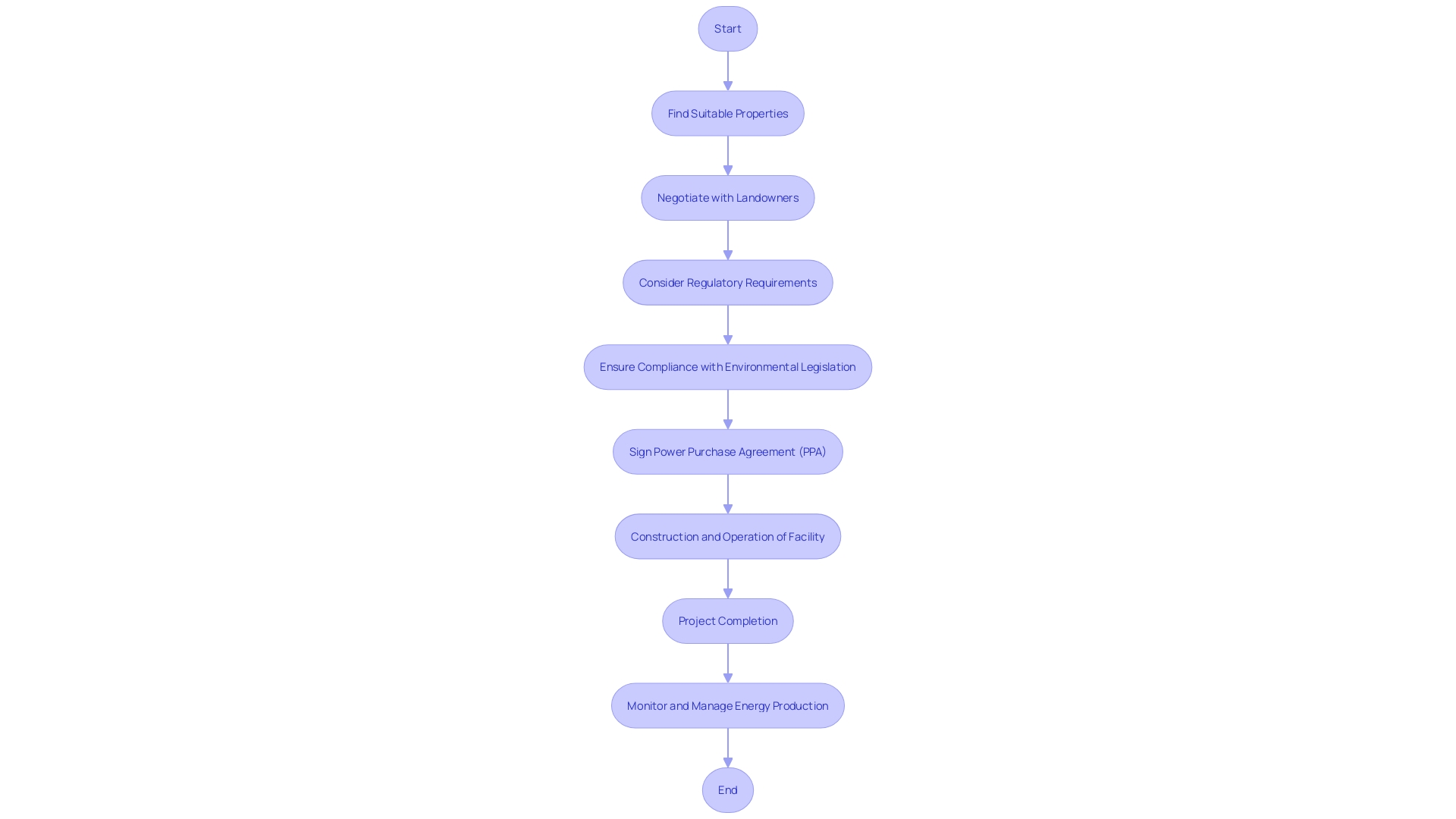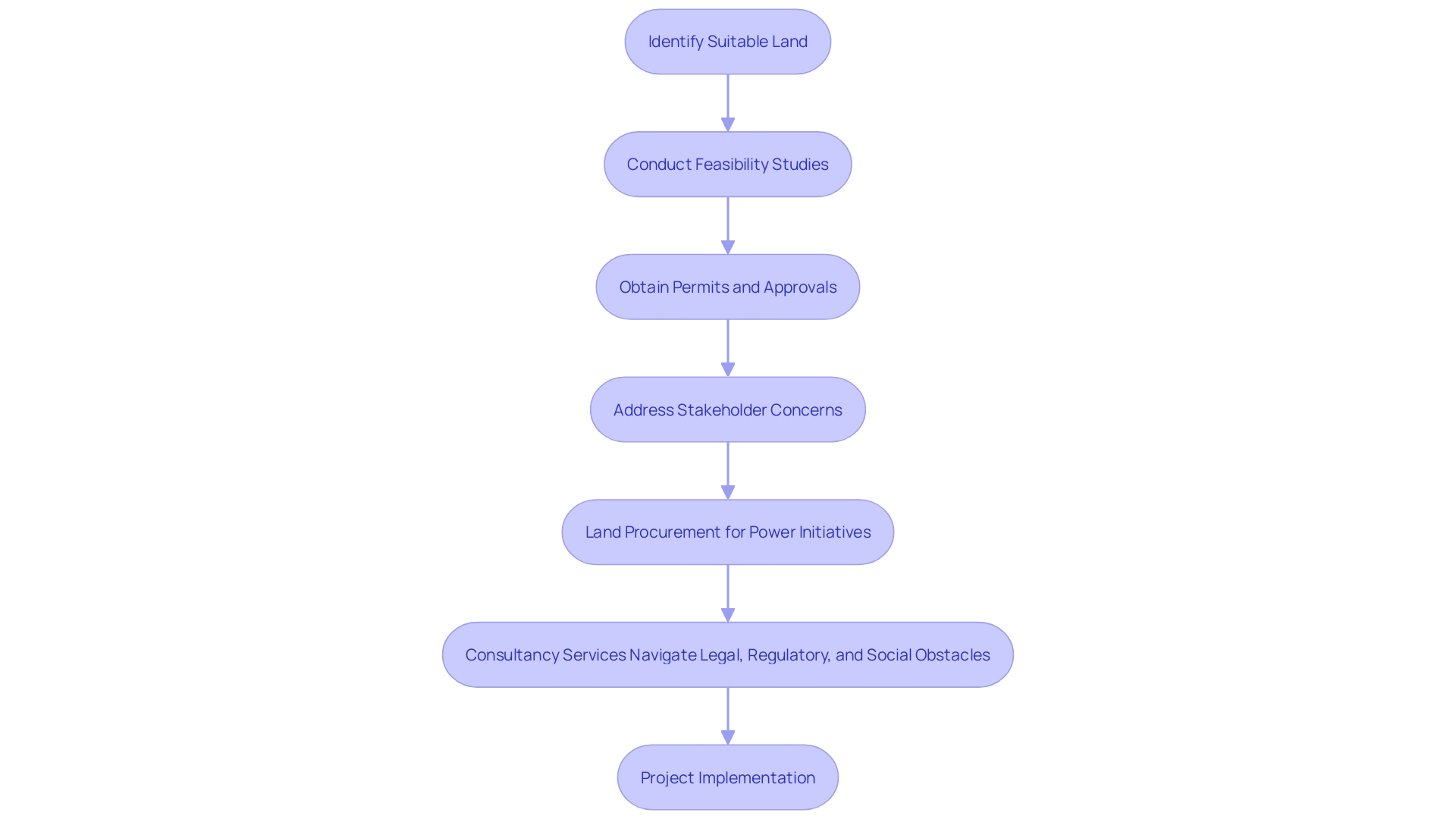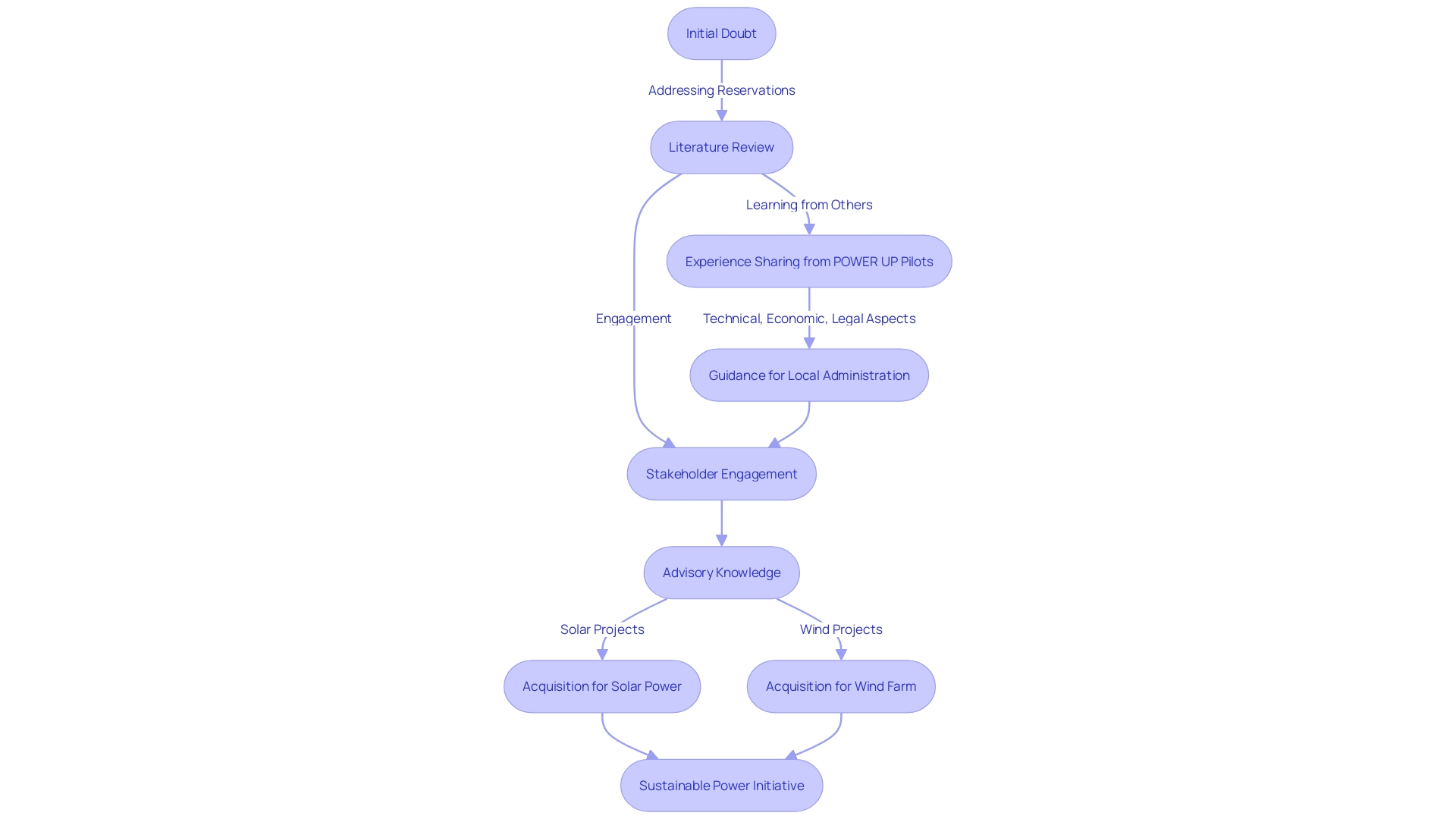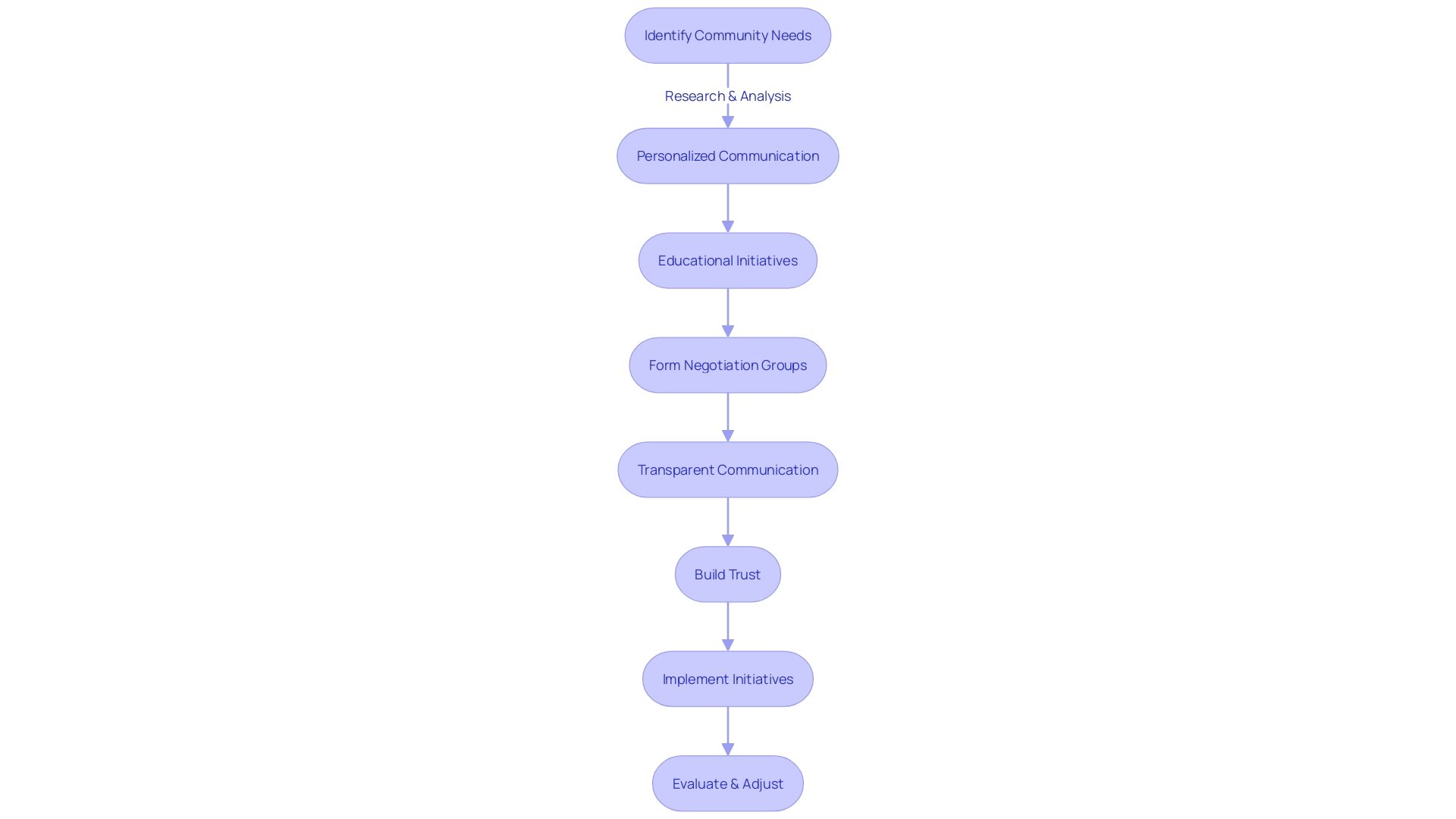Introduction
The acquisition of land is a crucial step in the development of renewable energy projects. These initiatives require ample space to install infrastructure like solar panels, wind turbines, or hydroelectric power plants. However, securing suitable land for these projects is not without its challenges.
From navigating complex regulatory landscapes to addressing environmental and community concerns, the process demands a comprehensive approach. In this article, we explore the importance of land acquisition in renewable energy projects, the key challenges involved, the benefits of consulting services, successful case studies, the role of ESG in sustainable energy development, strategic planning and management for energy efficiency, navigating regulatory environments and compliance, and community engagement strategies. By delving into these topics, we aim to provide valuable insights into the multifaceted world of land acquisition for renewable energy projects.
The Importance of Land Acquisition in Renewable Energy Projects
The procurement of territory is a crucial measure in the progress of sustainable power initiatives, with eco-friendly initiatives demanding substantial area for the setup of infrastructure such as photovoltaic panels, wind turbines, or hydroelectric power stations. A solar farm, for instance, typically occupies 5 to 10 acres per megawatt of generating capacity, according to the Solar Energy Industries Association. The magnitude of these initiatives highlights the significance of comprehensively understanding the acquisition procedure for property, as it directly impacts the advancement and viability of eco-friendly energy endeavors.
Moreover, the tenure of leases for solar projects usually spans 20 to 30 years, but this can vary based on negotiations. During this time, property owners may have the chance to participate in other activities on the property, such as raising livestock or practicing agriculture, depending on the agreed terms. This practice of dual-use or co-location enables the area to be used more efficiently, generating multiple streams of revenue.
The difficulty of ensuring access to natural resources for sustainable power investments is especially severe in light of worldwide climate change, particularly in developing nations. The cost of adapting to climate change in these regions could reach $390 billion this decade, far surpassing current investments of $20–25 billion per year. With public funds unlikely to bridge this gap, enhancing private financing for climate adaptation is crucial. Effective systems for land acquisition empower both governments and the private sector to invest more confidently in renewable power and other climate-smart infrastructure.
Solar power, praised as the instrument with the highest potential to decrease carbon dioxide emissions by 2030, is expected to make up almost 60% of all new utility-scale electricity-generating capacity installed in 2024 in the U.S., as forecasted by the Department of Energy. Yet, the search for appropriate locations for solar development often overlaps with croplands or grasslands, requiring a balance between power generation and ecological preservation.
The solar industry's expansion is also accompanied by the need to navigate intricate regulatory landscapes, including zoning laws, usage permissions, and environmental assessments. Experienced solar companies can help landowners navigate these compliance procedures to acquire the required authorizations and licenses, thus expediting the advancement of solar initiatives.
In conclusion, comprehensive acquisition strategies are not only crucial for the physical implementation of sustainable power initiatives but also for improving the investment environment and addressing the global urgent climate objectives.
Key Challenges in Land Acquisition for Energy Projects
Acquiring suitable sites for power projects is a complex undertaking, encompassing a range of factors to guarantee that the chosen plots fulfill the intricate requirements of such endeavors. The process is not only about finding property with the right characteristics but also about the broader implications of its use. For example, the conversion of the power system requires the strategic choice of property near transmission lines while considering the environmental effects and the socio-economic structure of the local community. The complexity of this task is heightened by the obligation to provide just compensation to landowners, which requires robust negotiation skills to reach an equitable settlement.
Recent developments underscore the magnitude of this undertaking. The Department of the Interior's advancement of 15 sustainable power initiatives, which will sprawl over 118,000 acres and potentially generate enough electricity to power four million households, is a testament to the scale at which land acquisition for power initiatives is occurring. These projects, positioned to utilize solar, geothermal, and other renewable resources, reflect the increasing momentum towards a sustainable transition that is both physically and regulatory intense.
The transition's scope, as outlined in comprehensive industry reports, includes seven domains undergoing significant transformation, from power generation to carbon reduction strategies. This underscores the systemic shift towards low-emission energy sources and the critical role of new fuels like hydrogen. Such a transition is not just about technology but also about adjusting our use of the territory to accommodate these changes.
Navigating the legal landscape adds another layer of complexity, with environmental legislation such as the National Environmental Policy Act (NEPA) potentially introducing delays and increased costs to development endeavors. These regulatory hurdles, while aiming to safeguard the environment, also present challenges that demand a keen understanding of compliance and strategic legal foresight.
As the environment changes with fast developments in sustainable sources such as wind, solar, and biogas, the related need for suitable areas that can accommodate the required infrastructure, including transmission lines, becomes more pressing. This transformation, propelled by the necessity to decrease carbon emissions, additionally enhances the requirement for acquisition strategies that are as adaptable and future-oriented as the initiatives they endorse.

Benefits of Consulting Services in Energy Projects
Maximizing land procurement for power initiatives necessitates maneuvering through a complex network of legal, regulatory, and social obstacles. Consultancy services are instrumental in this process, providing the technical and strategic expertise necessary to tackle these complexities. As we move towards ambitious global targets, such as the Sustainable Development Goal 7 (SDG 7) for universal access to sustainable power by 2030 and the Paris Agreement's climate objectives, the role of power advisors becomes even more crucial. These experts are knowledgeable about the regulatory landscapes, which, as the Handbook on Customs Benefits for Sustainable Power specifies, involve navigating customs and tax advantages, import duties, and taxes relevant to sustainable power initiatives.
The significance of consultancy services is emphasized by the recent progress of 15 renewable resource initiatives by the Department of the Interior. These initiatives, spanning across Western states in the U.S., necessitate a comprehensive understanding of the National Environmental Policy Act (NEPA) and other regulatory frameworks that could introduce delays and additional compliance costs. Consultants help mitigate these risks by providing insights into project economics, operational requirements, and stakeholder engagement strategies, ensuring projects proceed with minimal hindrances.
Moreover, the knowledge of consultants has been crucial in the sector's transition towards sustainability and efficiency. For instance, energy-efficiency consultants from National Grid have successfully helped clients like Albany Medical Center to realize substantial savings through on-site assessments and the implementation of energy-efficient upgrades. These consultants play a pivotal role in identifying financial incentives and beneficial programs, advocating for solutions like high-efficiency heat pumps, heating equipment, and electric vehicle charging programs.
The evolving power landscape, marked by a projected $12 trillion investment in renewables and grid development in North America by 2050, as reported by the Energy Transition Outlook North America, demands a strong and coherent approach. Consultancy services not only offer the structure for efficient stakeholder communication but also guarantee the viability and hands-on implementation of power initiatives. The assistance and advice of consultants throughout the acquisition process are priceless, especially as the industry navigates the shift to more sustainable power sources, like the expected prevalence of solar photovoltaic (PV) in the power supply of the Middle East by 2040.

Case Study: Successful Land Acquisition and Consulting for Renewable Energy
An outstanding example of acquiring property strategically for sustainable power initiatives includes a wind farm endeavor on a ranch, where the initial doubt of the proprietor, Pete Ferrell, was converted into a groundbreaking acceptance of wind power. Ferrell, initially resistant to the idea of altering his ranch's landscape, was persuaded after a patient and educative approach by the proposing company, which included a visit to an established wind farm in California. This case illustrates the critical role of stakeholder engagement and the importance of addressing initial reservations through direct experience and dialogue.
In the domain of solar power advancement, a sustainable power organization confronted the double difficulties of securing proper property in a limited area and gaining community backing. The company's triumph relied on a blend of thorough planning and skillful negotiation, augmented by the proficiency of a consultant specialized in the field. The consultant guided them through the intricate regulatory landscape, ensuring that environmental concerns were duly addressed and that all necessary permits and licenses were in compliance. This forward-thinking method to property acquisition, emphasized by the incorporation of advisory knowledge, is evidence of the increasing acknowledgement of holistic approaches in promoting environmentally-friendly initiatives.
The convergence of land acquisition for sustainable power projects with wider ecological and industry goals is further emphasized by the World Cement's EnviroTech conference. This assembly of business participants, from cement manufacturers to technical specialists, highlights the need for creative methods and regulations that reduce the environmental impact of industry activities, aligning with the sustainable principles of alternative power advancements.
Furthermore, the International Agency for Sustainable Power (IASP) offers valuable perspectives on the allocation and capability of sustainable power technologies. IRENA's statistics reveal an upward trajectory in power capacity from sustainable sources, measured in megawatts (MW), and electricity generation in gigawatt-hours (GWh), reinforcing the significance of clean power in the global energy mix. This information underscores the significance of acquisition strategies that align with the growing reach of sustainable power installations globally.

Role of ESG in Sustainable Energy Development
The incorporation of Environmental, Social, and Governance (ESG) factors into acquisition strategies is not only a fad but a strong method to guarantee the sustainability of developments. ESG principles serve as a guide for assessing the environmental impact, interacting with communities, and maintaining ethical practices within energy initiatives. Energy companies, such as those in Massachusetts, have observed the harmful effects of not aligning their property acquisition methods with ESG standards. More than 5,000 acres were deforested for solar initiatives, resulting in the emission of substantial amounts of CO₂ and undermining the integrity of the natural ecosystems that play a vital role in absorbing greenhouse gases.
On the other hand, Vietnam's ambitious goals in the power sector highlight the significance of ESG. The country aims to reduce emissions by 43.5% by 2030, with a vision for net-zero carbon emissions by 2050, leveraging its substantial wind power capacity. This demonstrates the worldwide transition towards sustainable practices and the increased importance of ESG in the acquisition of land for power projects.
The adoption of ESG is not only driven by environmental and social imperatives but also by the profound impact it has on the industry's operational resilience. Utilities are increasingly vulnerable to natural disasters, which not only cause high repair costs but also affect local communities through power outages and property damage. Implementing ESG principles can mitigate these risks and foster nature-positive operations.
Furthermore, the Advanced Distribution Management System test bed exemplifies how utilities can simulate and test their ESG-aligned investments in a sandbox environment, leading to innovative solutions like updated fault identification schemes. This proactive approach on ESG supports the transition to clean power in a way that is socially equitable, economically viable, and environmentally responsible. The insights from REN21's Renewable Energy and Sustainability Report reinforce this, showing that while renewables have potential negative impacts, these can be effectively mitigated to maximize the sustainability benefits.
As the power scenery changes, it's clear that ESG considerations are vital for the long-term accomplishment and acceptance of power projects. It's a strategic approach that not only addresses the pressing issues of climate change but also resonates with the growing demands for responsible investing and corporate governance. Companies that embrace ESG principles in their acquisition processes are poised to take the lead in the worldwide shift towards a more sustainable and equitable future for power.
Strategic Planning and Management for Energy Efficiency
The focus on enhancing the development of sustainable power sources is growing more advanced, with a significant emphasis on maximizing the utilization of resources to attain optimal electricity generation. By implementing effective approaches, it is feasible to reduce land usage while increasing the production of solar and wind resources. This necessitates meticulous planning in site selection, layout configuration, and operational efficacy to enhance the sustainability of such initiatives. For example, observations from the POWER UP pilot projects uncover the importance of merging technical, economic, and legal considerations to enhance the efficacy of local renewable endeavors. These pilots, spanning Valencia, Roznov, Eeklo, and other European cities, demonstrate how to harmonize solar and wind technologies with local infrastructure and regulations. Moreover, the EU's 'Fit for 55' package and subsequent REPowerEU plan demonstrate a continental dedication to sustainable power, requiring member states to modify their national legislations to promote a greener landscape. As large-scale solar power becomes a pivotal player in reducing carbon emissions, it is essential to recognize the potential of agrivoltaics, which synergizes agriculture with solar power generation, promoting a sustainable coexistence with local ecosystems. This evolving landscape emphasizes the importance of energy-efficient technologies as critical allies in curbing demand for power across various sectors, thereby supporting a cleaner, more resilient future. The International Agency for Sustainable Power (IASP) offers a comprehensive overview of sustainable power capacities and generation data, showcasing the expansion and distribution of such technologies globally. This information emphasizes the importance of a thoughtful and environmentally conscious approach to sustainable power initiatives, ensuring they make a positive impact on both nearby neighborhoods and the broader objective of a viable energy shift.
Navigating Regulatory Environments and Compliance
The environment for the development of initiatives is as ever-changing as it is demanding, with the shift to alternative sources of power bringing forth a wave of fresh challenges and opportunities. With the growing attention on sustainable power sources, the siting and development of these projects have become increasingly intricate. This intricacy is because of the reality that sustainable resources are frequently situated in distant regions, demanding a reimagining of conventional transmission pathways to fulfill the requirements of a clean economy—challenges outlined in reports predicting a $12 trillion investment in clean power and grid development by 2050.
With the U.S. transmission system historically designed to support central station power plants, the move towards dispersed sustainable resources calls for extensive infrastructure buildout. The significance of this shift is emphasized by federal funding initiatives, where utilities and organizations have obtained $600 million to support grid resilience and other sustainable power initiatives. However, developers encounter a diverse scenery where every state offers a distinct regulatory setting for the siting and permitting of sustainable power initiatives.
The regulatory hurdles are not just a matter of compliance; they embody the broader societal concerns about safety, environmental impact, and economic tradeoffs. California's approach to utility regulation, for instance, reflects a nuanced balance between safety standards and economic implications, where reputational risks for utilities are a significant factor due to the potential impact on public electricity rates.
In the midst of this setting, consultants specializing in power initiatives become essential allies for developers. Their expertise is crucial in navigating the nuanced policy landscape, where a report by the U.S. Department of Energy emphasizes the diverse state-level approaches to sustainable power planning and approval. Consultants provide the essential guidance to navigate this intricate landscape, ensuring that endeavors not only fulfill the technical and economic criteria but also adhere to the environmental and safety standards that are increasingly prominent in public discussions.
As the demand for sustainable power increases, the significance of these advisors is emphasized by the urgent requirement for reliable allies who comprehend both the financial and technological aspects of power scheme progression. Their insights are pivotal in managing the risks associated with catastrophic events, such as wildfires, and in implementing safety measures that can result in economic tradeoffs for the general public.
Essentially, the effective execution of power initiatives in the present swiftly changing environment relies on a proactive strategy to regulatory adherence and stakeholder involvement—a duty made possible through the proficiency of experienced power initiative advisors.
Community Engagement and Public Acceptance Strategies
The incorporation of power initiatives within neighboring communities is a complex undertaking that relies on the foundation of community involvement and public approval. To accomplish this, developers must engage in proactive and personalized communication with the residents, much like the grassroots approach taken in Selwerd-Zuid. Here, individual outreach was essential due to the absence of a pre-existing community collective, emphasizing the need to address the intricacies of each locale.
Educational initiatives, such as the 'Harnessing Hydrogen' interactive activity, underscore the importance of enlightening communities on the technological and environmental nuances of projects. This type of engagement cultivates an understanding of the benefits and implications of hydrogen supply chains, thereby fostering a more informed community support base.
Nonetheless, the mere signing of legal agreements has proven insufficient for genuine community engagement. RMI's research highlights the pitfalls of unrepresentative negotiation groups and paves the way for more inclusive practices that reflect the collective will of the entire community. This is critical, as demonstrated by the backlash from communities where agreements failed to capture their true interests.
Additionally, the establishment of new transmission lines, vital for unleashing clean power potential, demonstrates the significance of transparent and advantageous communication with host communities. Lessons from initiatives like the Colombian renewable power initiative for indigenous groups, where local and indigenous leadership have been empowered to collaborate in electricity generation, emphasize the potential for mutual benefits and trust-building.
In the realm of carbon dioxide removal technology, the historical context of the oil-and-gas industry's impact on local health and environment further underlines the necessity of earning trust through transparent and considerate stakeholder engagement.
As the Australian Government's acceptance of the Independent Scientific Committee on Wind Turbines' Community Engagement Review recommendations indicates, there is a national acknowledgment of the need for improved engagement strategies. These approaches must be based on a foundation of trust and transparency, which are not just beneficial but essential for the long-term success of initiatives in the field of power.
In summary, successful community involvement for power initiatives is not a universal remedy but a customized strategy that honors the distinct characteristics of every community, prioritizes their concerns, and communicates the concrete advantages of power undertakings. It is through this lens that developers can anticipate and surmount the inherent challenges of integrating energy projects within the social fabric of local communities.

Conclusion
In conclusion, land acquisition is a crucial step in the development of renewable energy projects. Securing suitable land involves navigating complex regulatory landscapes, addressing environmental concerns, and engaging with local communities. Consulting services play a vital role in optimizing land acquisition by providing technical and strategic expertise.
Successful case studies highlight the importance of stakeholder engagement and integrating consulting expertise. The integration of Environmental, Social, and Governance (ESG) factors is essential for sustainable energy development. Strategic planning and management are crucial for optimizing energy efficiency.
Navigating regulatory environments and compliance is a demanding task that requires expert guidance. Community engagement and public acceptance strategies are vital for successful project integration. In summary, comprehensive land acquisition strategies, consulting services, ESG principles, strategic planning, regulatory compliance, and community engagement are all essential components of successful renewable energy projects.
By embracing these elements, the energy industry can advance towards a more sustainable and equitable future.




